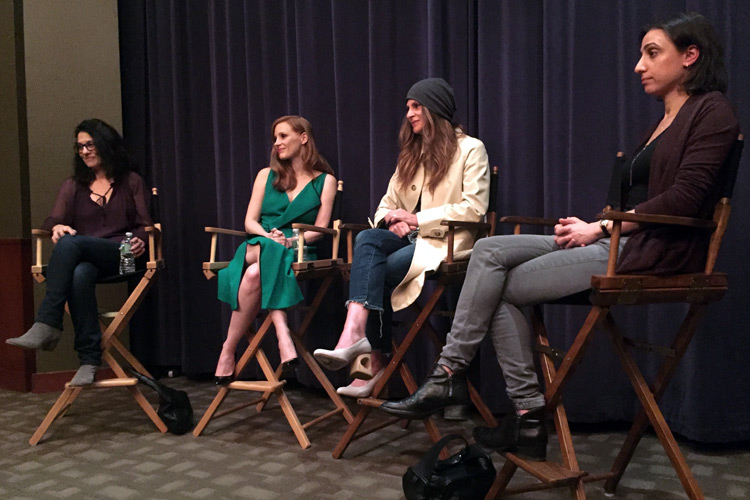The following questions and answers are excerpted from a conversation that followed the NBR screening of The Zookeeper’s Wife.
How did you make this film without relying on CGI? The animals are incredible.
Niki Caro: I couldn’t conceive of making an authentic movie out of this story about a female zookeeper with fake animals. I didn’t want to direct an animal on camera, so we created an environment where they were free to be themselves and to react and respond according to their individual natures. The way we were able to pull that off was Jessica Chastain. It was such a rare treat to see her work with the animals and share such an otherworldly kind of bond with them.
Jessica Chastain: There was never this feeling of capturing everything in the script and analyzing what was in front of us. The scene with Lily, the elephant, I had spent a lot of the time before the cameras were there so the animals wouldn’t feel like I was imposing myself on them. The first take of the elephant scene she was not interested in the puppet, but spending time with her I found that she loved apples and so I started to hide them. In that scene she’s actually looking for the apples. I remember thinking this is why I love what I do. It’s the magic of movie making and people thinking it’s an animal in distress, but it is disguised into something else.
“Antonina found her sanctuary here as she fled the darkness and created a place of love”
How difficult was it to shoot the scene where the zoo gets bombed?
Caro: When we in pre-production, I had my assistant go through the internet to find every little piece of an animal moving it’s head or seemingly reacting to something. I sent them over to my editor and asked him to put a sequence together to the sound of bombs to see if this would work because we never had the resources to make a huge sequence of the zoo being bombed. I felt that it would be good if the animal sensed the war before it came. If you take away the brilliant sound design of that sequence, you basically have a bunch of animals looking around. While the animals seem agitated, they’re not. The tiger was following the boom pole and the monkeys were playing with someone. It’s all created very organically and I just love this about making movies in an old school way. So many things nowadays can be achieved in the virtual effects world, but as an audience member I don’t feel the same way when it doesn’t feel authentic.
It’s incredible that Antonina’s diaries exist at all. What was the research process like, and how did you go about adapting it for the screen?
Angela Workman: Well, I primarily used Diane Ackerman’s book, and her book uses the diaries. Diane’s book is nonfiction and heavily researched. She was my greatest resource putting together this script. She sent me her research and photographs and it was very immersive. I spent a lot of time at the Holocaust museum in DC, which was immersive and moving. You learn everything about how the war began, the history of it, you’re watching videos and it’s incredibly painful to see. They brought in cobblestones from the streets and the museum is a pathway or journey that gets more painful as you go through.
Self-sacrifice is a common theme in war films, but feels unique here. How did you approach it in this particular story?
Workman: We talked a lot about that in the beginning and I don’t know that we could ever actually put ourselves in the mindset of these people that risked their family to do this. Instead, we focused on how we present and justify it. We had to think about what does it say about Antonina, that she does this while she has a son and a daughter. I think the only thing that we came up with was the greater impulse to save everyone and risk you life to do so, which meant also risking her family’s life.
Chastain: It was important also when we were filming the scenes that we not show that it was an easy decision. For Antonina and Jan to just do this, it undervalues the danger and sacrifice that they made. I love the scenes where Antonina questions and even pushes back and has doubts about doing the right thing. Otherwise it would diminish what she did.
You have a beautiful dialect in this film that blends in wonderfully with the European cast. How did you approach and prepare the dialect?
Chastain: For me it started with learning about Antonina. She was born in St. Petersburg and she fled to Warsaw once her parents were killed. Because of that and what the story was about, I wanted the feeling of Antonina being of another place. With creating the voice, I made sure the way she spoke was delicate, so I took certain pauses in places like she’s finding the right words. I pitched the voice higher based on what Teresa, Antonina’s daughter, said about her mother’s femininity. Then I worked with Joan Washington on an accent that was Polish, yet had a history of where she was from in Russia. The thing I kept thinking was that Antonina found her sanctuary here as she fled the darkness and created a place of love. Now that the darkness is coming to her sanctuary, she’s going to maintain this space of love.

